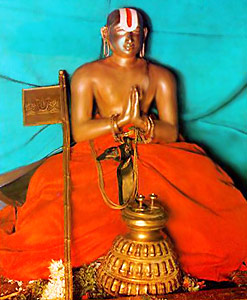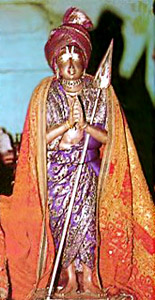The Ayyangars are members of a sect of South Indian Brahmins as are Srivaishnavas (community subscribing to the teachings of Madhava, who lived in the early fourteenth century). Ayyangars are the followers of Ramanuja (1037-1137) whose commentary on the Brahma Sutra gives an interpretation of the teachings of the Upanishads and the Gita which is different from others.
 The philosophy of Ramanuja is Visishtadvaita (qualified monism) and his theology is Srivaishnavism, the original exponent of the Visishtadvaita philosophy being Alavandar (or Yamunacharya) an elder contemporary of his, whose monumental work he completed after the master`s death. According to Ramanuja, the soul does not lose its identity in God when it attains salvation. It continues to retain its individuality and the highest spiritual duty of man is to so utilize the blessings of life that he may attain divine grace through service to God and His devotees which alone is the highest form of bliss. A unique feature of Ramanuja`s theology is the doctrine of Prapatti (unqualified self-surrender to God), a concept which is the philosophical culmination of the entire doctrine of `bhakti.`
The philosophy of Ramanuja is Visishtadvaita (qualified monism) and his theology is Srivaishnavism, the original exponent of the Visishtadvaita philosophy being Alavandar (or Yamunacharya) an elder contemporary of his, whose monumental work he completed after the master`s death. According to Ramanuja, the soul does not lose its identity in God when it attains salvation. It continues to retain its individuality and the highest spiritual duty of man is to so utilize the blessings of life that he may attain divine grace through service to God and His devotees which alone is the highest form of bliss. A unique feature of Ramanuja`s theology is the doctrine of Prapatti (unqualified self-surrender to God), a concept which is the philosophical culmination of the entire doctrine of `bhakti.`
Ramanuja, the great religious teacher, though a Tamil Brahmin by birth was a liberal. He taught that God`s grace is for everyone, whether high or low born, whether of the highest caste or an untouchable. If an individual makes an honest effort to achieve it, god will definitely bless him or her. He also believed that those treated as untouchables deserved special attention and called them Tirukkualattar (of the sacred caste), similar to the term Harijan (people of God) coined by Mahatma Gandhi.
Tamil is considered to be a sacred language by the Ayyangars because the Alvars composed their 4000 hymns in Tamil, which are held to the Tamil Vedas but Sanskrit, the language of the Vedas and the scriptures, continues to occupy a place of pre-eminence and Tamil has only supplemented, not supplanted it.
To the Srivaishnavas, the lives and works of the ten Alvars are as important as the works of Ramanuja himself.
The Tamil country was the cradle of the bhakti movement and some of the earliest saints, both Shaiva and Vaishnava, belong to Tamil Nadu. Their hymns are among the most beautiful compositions in Tamil literature and they are as popular today as they were in the times of the composers.
The Alvars flourished from about 600 to 900 AD. The majority was Brahmin by birth but men and women of high and low degree and of any caste joined the band of saints. The hymns composed by these Alvars, numbering four thousand are full of intense devotion and love for a personal god (Vishnu) and are still recited in the services held in the Vishnu temples of South India. these hymns are popularly known as Prabandha.
Andal (or Goda), one of the great Alvars spent her life in devotion to Krishna. As a mystic she produced poetry unrivalled for its beauty and emotional intensity.
 The most prolific composer among the Alvars was Nammalvar who was born in a Sudra family at Kurukur, now Alvar Tirunagari in the Tirunelvelli district. Tirumangai Alvar, who was a devotee of the deity in the Srirangam temple, was a brigand and highway robber before divine wisdom came to him through the grace of God.
The most prolific composer among the Alvars was Nammalvar who was born in a Sudra family at Kurukur, now Alvar Tirunagari in the Tirunelvelli district. Tirumangai Alvar, who was a devotee of the deity in the Srirangam temple, was a brigand and highway robber before divine wisdom came to him through the grace of God.
The literature produced by Srivaishnava scholars, composers and saints from the time of the Alvars to the end of the 16th century on philosophy, religious poetry, commentaries and others, adds up to a stupendous total. Some of this is highly sectarian and argumentative and is designed to demolish the thesis of other protagonists like the Advaitins, Buddhists, Jains and Charvakas.
In the 14th century the community was split into the two schismatic schools-- the Tengalai (southern sect) and the Vadagalai (northern sect). The members can be identified by the distinctive mark of each sect which is worn on the forehead. In the course of time the two sects fell out and inter-marriage and other types of associations between them came to be frowned upon.
After the schism of the 14th century, dividing the followers of Ramanuja into the Tengalai (led by Manavala Mahamuni) and the Vadagalai (led by Vedantadesika) several new works were written full of sophistry and philosophical hair-splitting. The separatism is, however, disappearing now as far as the more liberal and enlightened members of the community are concerned.
The suffix "Ayyangar", like Ayyar, has a Sanskrit origin. Both are derived from "Arya", a form of respectful address reserved in ancient days for Brahmanas and Kshatriyas; "Arya" becoming "Ajja" in Prakrit and then "Ayya" in Dravidian (Tamil, Kannada and Telugu).
The name Srinivasan is very common and shows the popularity of the deity at Tirupati but has no regional or caste denotation like Ranganathan, Varadarajan and Sarangapani, which are traceable to Srirangam, Kanjivaram, Kumbakonam and other religious cities.
Of the Brahmin population of South India, which is roughly about 4 % of the total, Ayyangars account for about 10 %. But their contribution to philosophy, religious lore, literature, art, science, social reform and politics is far out of proportion to their numerical strength. Many Ayyangars have occupied leading positions in several walks of life.
The famous personages hailing fom this particular community are as follows:-
•Chakravarti Rajagopalachari, the first and the last Indian governor-general of India, at the time of independence
•Vyajantimala and Hema Malini, the film actresses
•Srinivasa Ramanujanm, one of the greatest mathematicians of modern times
•"Poochi" Ayyangar, "Tiger" Varadachari and Ariyakudi Ramanuja Iyenagar, who greatly enriched Carnatic music
•C.V. Narasimhan, under secretary-general at the United Nations
•G. Parthasarathy, former Indian representative at the United Nations
•Ananthasayanam Ayyangar, deputy Speaker and Speaker of the Lok Sabha and governor of Bihar
•Salem Vijayaraghavachariar and S. Srinivasa Iyengar, leaders in the national struggle
•Prativadi Bhayankaram, (author of Craig`s Paradise describing the inhuman prison conditions in the Andamans)
•G. Subramanya Iyer and Veeraraghavachariar (who started the newspaper, The Hindu)
•Prativadi Bhayanakaram Annangarachariar and Agnihotram Thathachariar, the Sanskrit scholars
•K.S. Krishnan, physicist of international repute
The orthodox Ayyangar of yore, branded with the symbols of the conch and discus on his shoulders, learned only in the religious lore of his community. It is painted all over with the marks of Vishnu, bigoted, exclusive, insular and indifferent to the spiritual or cultural attainments of others. But he can still be met with in remote centers in the countryside or well-known Vaishnava temple towns.
Today`s orthodox Ayyangar wakes up with bird song and goes to the waterfront for a bath. He paints the namam prominently on his forehead and specified parts of his torso after putting on fresh clothes, he performs his japam or the Gayatri Mantra. Coming back home, he reads portions of the Ramayana and select religious texts. Then he offers his midday prayers to the sun, after which he starts the worship of his family icons. All this takes him up to lunch time. The lunch, prepared at home, is presented to the family diet as an offering before it is partaken. After the meal he retires for a while. If he is well versed in the Vedas or the Nalayiram, he might spend some time giving lessons to young pupils. At dusk he does his evening ablutions and sandhya again, after which he recites the Vishnu Sahasranamam and other stotras (compositions in praise of God). When this is over his dinner is served to him.
Culturally, Srivaishnavas are principally Tamils though thousands belong to Andhra Pradesh with Telugu as their mother tongue. For the majority of Srivaishnavas, including those who have settled far beyond the confines of the Tamil country for unremembered generations, Tamil is still the mother tongue.




















